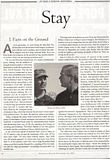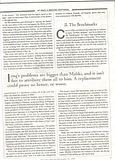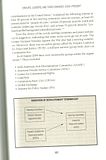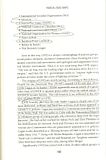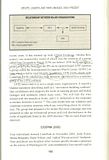Myths and Truths About Soy
Starting Out
While I have already posted on this topic, I am going to do a more in-depth blog on this matter (at the “The Drinking Hole”) that I will post here. Mind you I do not post much at this site [The Drinking Hole site] in general (as my interests ultimately lie elsewhere), but this topic is one that I believe needs more reflection by those persons who feel that Soy is “the way to either replace proteins, vitamin B12, or simply ad to a “healthy” diet.
Myths
One of the first myths is that the Asian world eats a lot of it. The truth of the matter s quite different than others would have us believe. The average consumption of soy foods in
This is a refutation of what I am constantly told by many – at my work – that al we need to do is look to the Asian culture for evidence of health verses quantity of intake. Another myth that bugs me is the myth that soy products, even fermented soy products (which are superior to regular soy more common to large production quantities), provide a good source for vitamin B12 in vegetarian/vegan diets. The truth of the matter is that the compound that resembles vitamin B12 in soy cannot be used by the human body; in fact, soy foods cause the body to require more B12.
Why do I delineate between fermented soy and modern production methods which differ from the ancient ways of producing soy enriched products? Because fermentation neutralizes toxins in soybeans, and are processed in a way that denatures proteins and increases levels of carcinogens. Denatured is defined as used here as:
- to cause the tertiary structure of a protein to unfold, as with heat, alkali, or acid, so that some of its original properties, especially its biological activity, are diminished or eliminated.
This is what effectively isn’t being done in most of today’s modern soy products, speaking here of many of the tofu’s and soy milks as well as the many other products.
Greedy Corporate Soy Producers!
From soy milk, tofu, and textured protein to mayonnaise, bakery products, margarine, and ice cream, soy products may be found in most processed foods in the supermarket and fast food chains, inflicting hormonal imbalances which may lead to cancer, osteoporosis, obesity, heart disease, sexual development abnormalities, learning disabilities, immune deficiencies, and infertility. The US Government sends soy products to foreign lands to mitigate hunger and malnutrition and thus causes even greater malnutrition, despite nearly half a century of research warning of the dangers of soy products.
"The industry has known for years that soy contains many toxins. At first they told the public that the toxins were removed by processing. When it became apparent that processing could not get rid of them, they claimed that these substances were beneficial. Your government granted a health claim to a substance that is poisonous, and the industry lied to the public to sell more soy." Sally Fallon, Nourishing Traditions: The Cookbook that Challenges Politically Correct Nutrition and the Diet Dictocrats (1999, 2nd edition, New Trends Publishing)
This is another thing that baffles me. Most of the people that follow these diets tend to be liberal, and many of these liberal person’s have a “conspiratorial eye” towards corporations and their greed factor as well as the government aspect, specifically government “funded” by corporations. These people generally do not trust all the products these corporations push, but they say this while not connecting the fact that the soy industry is a huge multi-billion-dollar making conglomerate of corporately owned money making people that will not allow negative news about their products to reach the common man. Now obviously I do not adhere to these conspiracy theories as do my more left-leaning counterparts. But for them to believe that only products they don’t use are guided by corporate entities is, well, an uneducated supposition. I hear about who funded which study in regards to countering anthropogenic global warming, but this same criteria is not applied to their own “golden calves.”
"Each year, research on the health effects of soy and soybean components seems to increase exponentially. Furthermore, research is not just expanding in the primary areas under investigation, such as cancer, heart disease and osteoporosis; new findings suggest that soy has potential benefits that may be more extensive than previously thought."
So writes Mark Messina, PhD, General Chairperson of the Third International Soy Symposium, held in Washington, DC, in November 1999.1 For four days, well-funded scientists gathered in Washington made presentations to an admiring press and to their sponsors - United Soybean Board, American Soybean Association, Monsanto, Protein Technologies International, Central Soya, Cargill Foods, Personal Products Company, SoyLife, Whitehall-Robins Healthcare and the soybean councils of Illinois, Indiana, Kentucky, Michigan, Minnesota, Nebraska, Ohio and South Dakota.
The symposium marked the apogee of a decade-long marketing campaign to gain consumer acceptance of tofu, soy milk, soy ice cream, soy cheese, soy sausage and soy derivatives, particularly soy isoflavones like genistein and diadzen, the oestrogen-like compounds found in soybeans. It coincided with a US Food and Drug Administration (FDA) decision, announced on October 25, 1999, to allow a health claim for products "low in saturated fat and cholesterol" that contain 6.25 grams of soy protein per serving. Breakfast cereals, baked goods, convenience food, smoothie mixes and meat substitutes could now be sold with labels touting benefits to cardiovascular health, as long as these products contained one heaping teaspoon of soy protein per 100-gram serving.
These industries and corporations have a lot of money invested in as well as to be made by selling their product. So these people are not un-biased in their “marketing of soy products. One customer asked what the problem with adding soy to diets would be, I will explain some of the adverse effects of it, as well as exploding a big myth about something I hear all the time, which is, blaming early puberty on anti-biotic and steroid infused Beef. I will argue that as more soy is added to products we will see earlier puberty in females and more erectile dysfunction (ED) in men. Not to mention an increase in obesity in children and adults.
Childhood Obesity, Early Puberty, Erectile Dysfunction
Estrogenic isoflavones, such as genistein and daidzein, are present in virtually all natural-ingredient rodent diets that use soy as a source of protein. Since these compounds are endocrine-active, it is important to determine whether the amounts present in rodent diets are sufficient to affect sexual development. The present study consisted of in vitro and in vivo parts. In the in vitro portion, human hepatoma cells were transfected with either rat estrogen receptor (ER) alpha or beta plus an estrogen-responsive luciferase reporter gene. Genistein and daidzein were complete agonists at both ERs, genistein being more potent than daidzein, and both compounds were more potent at ER beta than ER alpha. In combined studies with estradiol, genistein exerted additive effects with estradiol in vitro. In the in vivo portion of the study, groups of six pregnant Sprague-Dawley females were fed one of the following four diets, and the pups were maintained on the same diets until puberty: (1) a natural-ingredient, open-formula rodent diet (NIH-07) containing 16 mg genistein and 14 mg daidzein per 100 g of feed; (2) a soy- and alfalfa-free diet (SAFD) in which casein and corn oil were substituted for soy and alfalfa meal and soy oil, respectively, that contained no detectable isoflavones; (3) SAFD containing 0.02% genistein (GE.02); or (4) SAFD containing 0.1% genistein (GE.1). In the GE.1 group, effects of dietary genistein included a decreased rate of body-weight gain, a markedly increased (2.3-fold) uterine/body weight (U/BW) ratio on postnatal day (pnd) 21, a significant acceleration of puberty among females, and a marginal decrease in the ventral prostate weight on postnatal day (pnd) 56. However, developmental differences among the groups fed SAFD, GE.02, or NIH-07 were small and suggested minimal effects of phytoestrogens at normal dietary levels. In particular, on pnd 21, the U/BW ratio of the GE.02 and NIH-07 groups did not differ significantly from that of the SAFD group. Only one statistically significant difference was detected between groups fed SAFD and NIH-07: the anogenital distance (AGD) of female neonates on pnd 1 whose dams were fed NIH-07 was 12% larger than that of neonates whose dams were fed SAFD. The results suggest that normal amounts of phytoestrogens in natural-ingredient rodent diets may affect one developmental parameter, the female AGD, and that higher doses can affect several other parameters in both males and females. Based on these findings, we do not suggest replacing soy- and alfalfa-based rodent diets with phytoestrogen-free diets in most developmental toxicology studies. However, phytoestrogen-free diets are recommended for endocrine toxicology studies at low doses, to determine whether interactive effects may occur between dietary phytoestrogens and man-made chemicals.
“Developmental effects of dietary phytoestrogens in Sprague-Dawley rats and interactions of genistein and daidzein with rat estrogen receptors alpha and beta in vitro,” Toxicol Sci 1999 Oct;51(2):236-44, by Casanova M, You L, Gaido KW, Archibeque-Engle S, Janszen DB, Heck HA. Chemical Industry Institute of Toxicology,
Epidemiological evidence suggests that isoflavone phytoestrogens may reduce the risk of cancer, osteoporosis, and heart disease, effects at least partially mediated by estrogen receptors alpha and beta (ERalpha and ERbeta). Because isoflavone dietary supplements are becoming increasingly popular and are frequently advertised as natural alternatives to estrogen replacement therapy, we have examined the effects of one of these supplements on estrogen-dependent behavior and ERalpha- and ERbeta-dependent gene expression in the brain. In the adult female rat brain, 17beta-estradiol treatment decreased ERbeta messenger RNA signal in the paraventricular nucleus by 41%, but supplement treatment resulted in a 27% increase. The regulation of ERbeta in the paraventricular nucleus is probably via an ERbeta-dependent mechanism. Similarly, in the ventromedial nucleus of the hypothalamus, supplement treatment diminished the estrogen-dependent up-regulation of oxytocin receptor by 10.5%. The regulation of oxytocin receptor expression in the ventromedial nucleus of the hypothalamus is via an ERalpha-dependent mechanism. Supplement treatment also resulted in a significant decrease in receptive behavior in estrogen- and progesterone-primed females. The observed disruption of sexual receptivity by the isoflavone supplement is probably due to antiestrogenic effects observed in the brain. These results suggest that isoflavone phytoestrogens are antiestrogenic on both ERalpha- and ERbeta-dependent gene expression in the brain and estrogen-dependent behavior.
“Soy isoflavone supplements antagonize reproductive behavior and estrogen receptor alpha- and beta-dependent gene expression in the brain,” Endocrinology 2001 Jul;142(7):2946-52, by Patisaul HB, Dindo M, Whitten PL, Young LJ. Center for Behavioral Neuroscience,
We report here the effects of oral micronized estradiol and soy phytoestrogens on uterine weight, choline acetyltransferase (ChAT) and nerve growth factor (NGF) mRNAs in the frontal cortex and hippocampus of ovariectomized young and retired breeder rats. Within each age category, 15 bilaterally ovariectomized rats were randomized equally into three groups: control (OVX), estradiol (E2), and soy phytoestrogens (SBE). The OVX rats were fed a casein/lactalbumin-based control diet; the E2 rats were fed with the control diet with added estradiol; and the SBE rats were fed with the control diet with added soy phytoestrogens. After 8 weeks of treatment, blood, uteri, frontal cortex, and hippocampus were collected at necropsy. Results showed that the uterine weights and serum estradiol concentrations were significantly higher in the E2 group compared with those in the OVX and SBE groups. In the hippocampus of young rats, E2 treatment resulted in significantly higher NGF mRNA levels than no treatment (OVX), and NGF mRNA levels in the SBE group were intermediate between the E2 and OVX groups. ChAT mRNA levels were significantly higher in the frontal cortex of E2 and SBE-treated retired breeder rats compared to OVX retired breeder rats. There were no differences among treatment groups for ChAT mRNA levels in the frontal cortex of young rats and in the hippocampus of both young and retired breeder rats. Our data suggest that soy phytoestrogens may function as estrogen agonists in regulating ChAT and NGF mRNAs in the brain of female rats.
“Effect of estradiol and soy phytoestrogens on choline acetyltransferase and nerve growth factor mRNAs in the frontal cortex and hippocampus of female rats,” Proc Soc Exp Biol Med 1999 Jun;221(2):118-25, by Pan Y, Anthony M, Clarkson TB. Comparative Medicine Clinical Research Center, Wake Forest University School of Medicine, Winston-Salem, North Carolina 27157-1040, USA. ypan@cpm.bgsm.edu
There are about 70 more such studies at Scientific Abstracts of Found at: SoyOn-Line.com. Too many to list in fact.
Dangers of Soy
So what are the dangers involved with soy in your diet? Lets see:
- High levels of phytic acid in soy reduce assimilation of calcium, magnesium, copper, iron and zinc. Phytic acid in soy is not neutralized by ordinary preparation methods such as soaking, sprouting and long, slow cooking. High phytate diets have caused growth problems in children.
- Trypsin inhibitors in soy interfere with protein digestion and may cause pancreatic orders. In test animals soy containing trypsin inhibitors caused stunted growth.
- Soy phytoestrogens disrupt endocrine function and have the potential to cause infertility and to promote breast cancer in adult women.
- Soy phytoestrogens are potent antithyroid agents that cause hypothyroidism and may cause thyroid cancer. In infants, consumption of soy formula has been linked to autoimmune thyroid disease.
- Vitamin B12 analogs in soy are not absorbed and actually increase the body’s requirement for B12.
- Soy foods increase the body’s requirement for vitamin D.
- Fragile proteins are denatured during high temperature processing to make soy protein isolate and textured vegetable protein.
- Processing of soy protein results in the formation of toxic lysinoalanine and highly carcinogenic nitrosamines.
- Free glutamic acid or MSG, a potent neurotoxin, is formed during soy food processing and added to many soy foods.
- Soy foods contain high levels of aluminum which is toxic to the nervous system and the kidneys.
(SOY INFANT FORMULA — BIRTH CONTROL PILLS FOR BABIES)
- Babies fed soy-based formula have 13,000 to 22,000 times more estrogen compounds in their blood than babies fed milk-based formula.
- Infants exclusively fed soy formula receive the estrogenic equivalent of at least five birth control pills per day.
- Male infants undergo a “testosterone surge” during the first few months of life, when testosterone levels may be as high as those of an adult male. During this period, baby boys are programmed to express male characteristics after puberty, not only in the development of their sexual organs and other masculine physical traits, but also in setting patterns in the brain characteristic of male behavior.
- Pediatricians are noticing greater numbers of boys whose physical maturation is delayed, or does not occur at all, including lack of development of the sexual organs. Learning disabilities, especially in male children, have reached epidemic proportions.
- Soy infant feeding—which floods the bloodstream with female hormones that inhibit testosterone—cannot be ignored as a possible cause for these tragic developments. In animals, soy feeding indicates that phytoestrogens in soy are powerful endocrine disrupters.
- Almost 15 percent of white girls and 50 percent of African-American girls show signs of puberty such as breast development and pubic hair, before the age of eight. Some girls are showing sexual development before the age of three. Premature development of girls has been linked to the use of soy formula and exposure to environmental estrogens such as PCBs and DDE.

